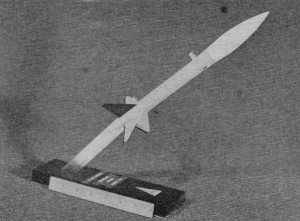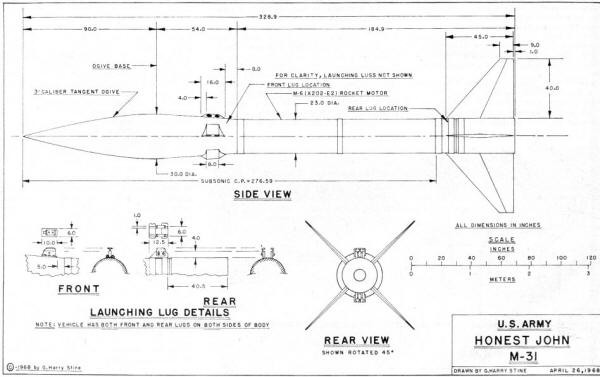|
I never built an
Honest John
rocket model when I was a kid, and to this day still do not own one. The vintage
kits on eBay are through-the-roof expensive. I always liked the unique design and
the look of the nose cone where it bulges out a bit from the diameter of the main
body tube. Both Estes and Centuri made versions of the Honest John. Intentionally
or not, there was an advertisement for the Centuri Honest John model on the page
opposite of the past part of the article in this September 1968 edition of American
Aircraft Modeler magazine, from which this page was scanned. The Honest John
M-31 artillery rocket was a surface-to-surface rocket that was developed by the
United States Army during the Cold War era. It was named after President John F.
Kennedy's campaign pledge to be an "honest" president.
Countdown: Honest John
Scale data, for use in model rocket competition, on the Army's first unguided artillery
rocket.
by G. Harry Stein
This information on the U. S. Army's Honest John M-31 artillery rocket provides
astromodelers with scale substantiation da-ta required under U. S. Model Rocket
Sporting Code, 1967 Edition. It enables use of scale model Honest John kits by both
Estes Industries, Inc. (Kit K-27) and Centuri Engineering Co. (Kit KC-25) for com-petition.
The Estes H-J kit is to a scale of 1:23.56; the Centuri H-J kit is to a scale of
1:25.33. The basic dimensional data on the M-6 (X202-E2) rocket engine can also
be utilized for scale models of those NASA rocketsondes using the M-6 - EXOS, Jason,
Javelin, etc.

Author's Honest John is very colorful with fluorescent red-orange,
white and black. It has held U. S. Class 2 Scale Altitude record and won NARAM-6
and 7 scale events.

H-J development round No. 1236F-M173 on the fixed-development
launcher at White Sands Proving Grounds, New Mexico. Upper left fin is all black,
other fins are white.
The honest John M-31 was the U. S. Army's first surface-to-surface unguided rocket
intended for use as a long-range artillery weapon. It consists of a nuclear or high-explosive
warhead mated to a large solid-propellant rocket motor. It is an unguided rocket
depending for stability in flight on four large fins. Its trajectory is pre-determined
by the azimuth and ele-vation of its 25-foot launching rail which is mounted on
a truck for mobility. Eight small solid-propellant spin rockets located in four
shrouds behind the warhead sec-tion in the nose are triggered by a mechanical trip
at the end of the launching rail and impart a slow roll to the missile in flight
to average-out fin and thrust misalignments in order to improve accuracy.
Honest John is a large artillery rocket capable of delivering a 2000-pound warhead
at distances up to 15 miles. It is now considered obsolete, having been replaced
by the smaller Little John rocket and the Lance rocket.
Development history: The Honest John's M-6 (X202-E2) solid propellant motor was
originally developed under the Bumblebee Program of the Applied Physics Laboratory
of John Hopkins University under contract to the U. S. Navy Bureau of Ordnance (BuOrd).
It was intended to be used as the rocket booster for the ramjet-propelled XSAM-N-6
Talos ship-to-air antiaircraft missile, but was later replaced in this use by an
improved solid propellant booster of larger diameter and shorter length.
In 1950, U. S. Army Ordnance Corps carried out some preliminary experiments at
White Sands Proving Ground, New Mexico, mating solid-propellant JATO (Jet-Assisted
Take-Off) rockets to inert warheads and stabilizing fins to investigate the possibilities
of creating an inexpensive battlefield artillery rocket for close fire support.
The successful completion of these experiments led to the Honest John in which the
available M-6 (X202-E2) solid propellant ex-Talos booster 23 inches in diameter
was mated to the 30-inch diameter special warhead available from the Sandia Corporation's
Special Weapons Laboratory.
 The first Honest John was launched from the
Army Launch Area #1 at White Sands Proving Ground on June 30, 1951. The author was
present, standing on the roof of a truck 1000 yards due west at Uncle Station. The
"H-J," as the missile came to be known at White Sands, surprised nearly everyone
with its exceedingly high noise level that was much greater than the German A-4
rockets then being flown at White Sands. It was the first time this booster, the
M-6, had been fired at White Sands, previous flight tests in the Bumblebee Program
having been conducted at the Naval Ordnance Test Station, China Lake, California. The first Honest John was launched from the
Army Launch Area #1 at White Sands Proving Ground on June 30, 1951. The author was
present, standing on the roof of a truck 1000 yards due west at Uncle Station. The
"H-J," as the missile came to be known at White Sands, surprised nearly everyone
with its exceedingly high noise level that was much greater than the German A-4
rockets then being flown at White Sands. It was the first time this booster, the
M-6, had been fired at White Sands, previous flight tests in the Bumblebee Program
having been conducted at the Naval Ordnance Test Station, China Lake, California.
Full mass production of the Honest John was started in 1952. Douglas Aircraft
Company was the prime contractor with Radford Arsenal manufacturing the M-6 CX202-E2)
rocket motor. At the time, the M-6 (X202-E2) motor was the largest production solid
propellant motor in existence in the free world.
From 1952 through 1957, hundreds of Honest John rounds were launched at White
Sands Proving Grounds for various purposes. Initially, launchings were made to determine
the battlefield range tables - the trajectories followed by the H-J as a function
of launcher elevation, wind velocities, and temperatures.
Early firings were made from trussed-rail-type launchers in the Army Launch Area
#1 at White Sands, and launchings were usually made two at a time with three minutes
between firings. Later, firings were made from the tactical mobile launch trucks
with their 25-foot launch rails. Test firings were also made from shortened truck
rails.
One modification of the H-J was the "Father John" missile, basically an H-J with
additional small solid propellant motors clustered around it. Only a few Father
John missiles were flown.
Considerable trouble was experienced with the quenching of the huge cloud of
dust and smoke kicked up by the launching of an H-J. The tremendous jet blast from
the missile created a thick cloud that rose as high as 1000 feet in the air. Such
a cloud would reveal an H-J launch site to the enemy at once and probably result
in making said launch site a prime target for enemy artillery at once. Naturally,
the technique of preventing such a cloud is highly classified!
By 1957, the Honest John M-31 was operational in the hands of special rocket
artillery troops and had been deployed overseas.
The M-6 (X202-E2) rocket motor: The M-6 (X202-E2) solid propellant rocket motor
is made by Radford Arsenal. It uses a modern composite solid propellant of classified
nature. Its length is 184.9 inches with a diameter of 23.0 inches. Launch weight
is 3783 pounds for the M-6 alone, less fins and launch lugs. The M-6 (X202-E2) produces
84,000 pounds of thrust for 5.20 seconds from 2050 pounds of propellant, resulting
in a calculated total impulse of 213 pound-seconds-per-pound. (The original M-6
produced 105,000 lbs. of thrust for 4 seconds and was known as "JATO 4-D5- 105,000.")
The basic M-6 CX202-E2) rocket motor is also used as the lower stage in several
of the ARGO-series of rocketsondes such as the EXOS and Javelin, both of these vehicles
also using the basic Honest John fin assemblies.
Color schemes: Few rockets can boast the varied number of color schemes used
on the Honest John. This is because of the fact that so many different rounds were
used for White Sands firings, where separate vehicles were often painted differently
to provide identification on film records. In addition, different White Sands paint
patterns were applied to aid tracking or data reduction for special test rounds
where, for example, roll rate or attitude had to be accurately determined from phototheodolite
film.
Most R&D flights of the Honest John at White Sands were painted flat white
overall. In nearly all cases, one fin and aft 34 inches of the motor casing were
painted flat black as follows, the missile resting on the launch rail and being
viewed from the rear: Upper left-hand fin painted black on both sides; the aft 34
inches of the motor casing painted black between the two left-hand fins. The black-and-white
checkerboard roll pattern forward and aft of the nose ogive base was, on all rounds
of this paint scheme, identical, the aft portion being alternately white and black
in circumferential quadrants as shown in the photos (two black quadrants and two
white quadrants) while the forward portion of the pattern is broken into eight circumferential
sectors and positioned with respect to the aft pattern as shown.
Rounds were also flown at White Sands painted fluorescent red-orange overall
with blacked fins as per above, no blacked aft motor quadrants, but blacked trailing
edges of all fins. Some of these had two spiral roll pattern bands wrapped halfway
around between the forward and aft motor bands. Other fluorescent red-orange rounds
had white ogives and transitions 105 inches back from the nose tip with blacked
fins as per above.
Operational rounds launched at Fort Carson, Colorado and Aberdeen Proving Ground,
Maryland, were flat olive drab overall, sometimes with white serial numbering, sometimes
with black serial numbering.
Lettering on the white-and-black White Sands rounds was usually confined to the
warhead serial number painted lengthwise on the ogive and consisting of the numbers
"1236F-" followed by the serial number of the round such as "M585" or "M521". The
word "TOP" in black appeared just forward of the forward launch lug. Sometimes the
serial number of the motor and the weights, CG location, and other data was stenciled
in black in 3-inch and I-inch letters on the side of the motor casing.
Data sources: This information on the U. S. Army Honest John M-31 rocket was
obtained from the following sources:

Honest John Scale Detail Drawing
<click for larger version>
Try out my Scale
Calculator for Model Airplane Plans.
https://www.modelaircraft.org/plans.aspx
Posted March 10, 2023
(updated from original post
on 7/7/2010)
|



